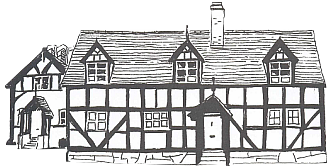Hodnet, Peplow and the BBC Domesday Project

In 1986 Hodnet, Peplow and the surrounding area took part in the Domesday project, organised by the BBC to coincide with the 900th anniversary of the original Domesday survey. The whole of the country was divided into D blocks, which were 4×3km rectangles, using OS map grid references.
Schools and community groups were contacted and asked to input information on to interactive laser discs, (which were cutting edge technology at the time), about daily life in their area. They were asked to record the ordinary not the extra ordinary and to consider in their input what people might find interesting in another thousand years time. The object of the exercise was to provide a colourful snapshot of everyday life, for each site. Some of the entries record interesting past history as well.
There are over 20 entries for the Hodnet area and 17 for the Peplow area including 3 photos for each site.
Here are some snippets.
Hodnet Charities administer monies left in wills and gifts from Jane Hill, Sir Rowland Hill, Jane Pratchett and other unknown donors prior to 1865. Its annual report in 1986 said it spent £645 on providing Xmas food parcels, and £934 on providing coal for the aged poor and needy in the parish.
Hodnet Fire Station was originally in Hearne Lane and had a horse-drawn engine with a hand pump. Historically, there was a fire station in the village as Sentinel steam lorries used to set fire to the thatched roofs of the black and white buildings. Current fire men are called up by personal “bleepers” but until 1983 they were summoned by a siren at the new station in Station Road.
The Hundred House was a residence in 1986 but for many centuries the villagers had the right to elect their own coroner on the steps of the building. They could sell local wine and beers if they hung a holy bush over the door and until the 1950’s an ancient court of Leet was held there every 7 years whereby the local Lord of the Manor could try the petty crimes of the villagers.
The Church of the Epiphany is a very small chapel which was the private chapel to Peplow Hall until 1948. Being a farming area the harvest festival was always very well attended.
Four farms in Peplow kept sheep. The usual yearly cycle was August to November the rams are put to the ewes. December to February the main flock of ewes lamb. In April the young ewes lamb and are detailed and castrated and kept until the next year to be sold as whethers. May to June the sheep are sheared. July to October the sheep are dipped for sheep scab. The main breeds used were Cluns, Texels and Suffolks.
By 1986 in dairy farming, shippons, where each cow had its own stall, were almost non-existent and had been replaced by parlours where the cow man stood in a pit below the cattle. The farmer was paid about 15p per litre and milk was sold to the housewife for about 45p.
In 1921 local land owners provided a rest room for the Irish potato pickers working in the county. After several changes and modifications this became Peplow’s Working Men’s Club.
There are also accounts of life as a pig farmer, life in a grocers and much more.
Technology at the time, failed the project by being too expensive. The discs were too easily damaged and information was not readily accessible. It was a great disappointment to all who took part.
BUT… The good news is that the information survived. Technology raced forwards and the project was again made available for update and perusal on the BBC Website in 2011. We reported on it here in May 2011.
The original information and the discs themselves have now gone in to the National Archive where they have been made into an interactive touch table display at Bletchley Park.
The BBC site in its present form will be available for some time to come and although it appears that no one from the area took the opportunity to provide updated information before the deadline it is still a fascinating glimpse into the not too distant past.

